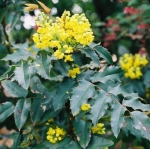| Common Name: |
Oregon Grape |
| Other Names: |
Mountain Grape |
| Botanical Name: |
Mahonia aquifolium |
| Genus: |
Mahonia |
| Family: |
Berberidaceae |
| Native Location: |
Native to western N America |
| Cultivation: |
Well-drained, rich soil in sun or partial shade. Mahonia aquifolium colors better in winter when planted in full sun. Cut back groundcover plants and old, straggly specimens hard in spring. Leafspot, powdery mildew, and rust may attack foliage. |
| Propagation: |
By seed sown in autumn (species only); by leaf-bud or semi-ripe cuttings from late summer to autumn. |
| Harvest: |
Roots and root bark are collected in late autumn or early spring, and dried for use in decoctions and liquid extracts. Fruits are collected when ripe and used fresh. |
| Variations: |
Apollo
Is vigourous, with a dense spreading habit, good for use as a groundcover; red-stalked, brown-tinged leaves that turn bronze in winter; and large clusters of bright yellow flowers.
Height: 60cm (24in) |
Compactum
Has glossier leaves that turn bronze in winter.
Height: 60-90cm (24-36in) |
Moseri
Has red-orange new foliage. |
Smaragd
syn.Emerald
Is compact, with large clusters of flowers.
Height: 60cm (24in)
Width: 1m (3ft) |
|
| Height: |
1-1.5m (3-5ft) |
| Width: |
1.5-2m (5-6ft) |
| Hardiness: |
Z5-8 |
| Parts Used: |
Roots, root bark, fruits. |
| Properties: |
A bitter, astringent, decongestant herb that stimulates bile flow and releases toxins. |
| Medicinal Uses: |
Internally for skin diseases (especially dry eczema), gall bladder complaints, chronic hepatitis B, catarrhal gastritis, and diarrhea. |
| Culinary Uses: |
Berries are added to fruit pies, jams, and jellies; they are also pressed for juice, which is added to fruit drinks or made into wine. |
| Bibliography: |
Encyclopedia of Herbs by Deni Brown Copyright © 1995, 2001 Dorling Kindersley Limited Pg 270
|

